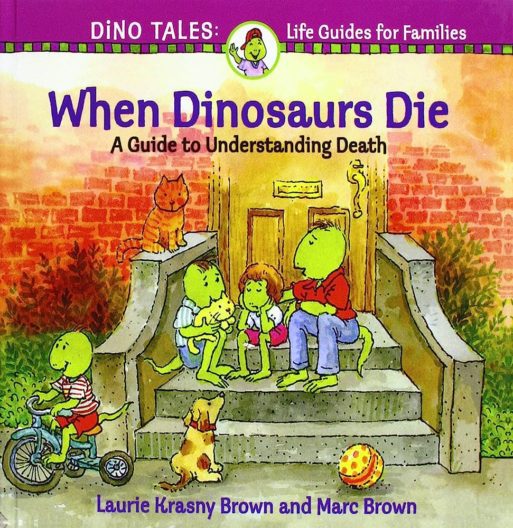 “What does alive mean?” is a pretty bold way to start a picture book for young children. But that’s the first sentence of Laurie Krasney Brown and Marc Brown’s “When Dinosaur’s Die,” printed in large letters at the top of the first page. I’ve read a good number of children’s books on death. But none of them asks this question so directly, and then answers it simply, without flowery language or metaphors.
“What does alive mean?” is a pretty bold way to start a picture book for young children. But that’s the first sentence of Laurie Krasney Brown and Marc Brown’s “When Dinosaur’s Die,” printed in large letters at the top of the first page. I’ve read a good number of children’s books on death. But none of them asks this question so directly, and then answers it simply, without flowery language or metaphors.
“During your lifetime, your body is busy doing its work,” the book explains. And then it talks about what that work entails: eating, breathing, touching, tasting, feeling and so forth. In simple language, “When Dinosaurs Die” settles the question of what it means to be alive in a total of four sentences.
Then you flip the page and you see the question, “Why Does Someone Die?” printed in bold across the top of the page. The book then explains that some people die slowly, while other deaths are “a complete surprise.” It goes on to discuss how lives can be very long or very short, and that even newborns sometimes die, simply because they’re not strong or healthy enough. It talks about the fact that people sometimes die violently, at the hands of other people. And some die “for reasons that are very hard to understand, such as poverty , prejudice and drug abuse.” The book even explains what suicide is.

Credit: youtube.com
A number or children’s books on death use plant analogies to discuss human deaths. But not “When Dinosaurs Die.” This book doesn’t talk about human death through the lens of an autumn leaf floating to the ground. Instead, “When Dinosaurs Die” lets its young readers know that death means “the heart stops beating” and “the brain doesn’t send or receive any messages” anymore. True, the book features human-like cartoon dinosaurs instead of actual cartoon humans. But these dinosaurs drive cars and wear plaid shirts, have blunt cut bobs and sleep in four poster beds. They’re as close to human as a cartoon dinosaur could possibly get.
“When Dinosaurs Die” also addresses grief in similarly explicit and specific terms. It lets kids know that after someone close to them dies, they might not be able to eat, and they might worry about their own death. The authors also wisely reassure children that “there’s no right or wrong way to feel” after a loved one dies. Thus, they normalize all responses that the book’s young reader might experience.
Ultimately, the message of “When Dinosaurs Die” is this: You will grieve when someone you love dies, and however you need to grieve is OK. Meanwhile, the important thing is for you to go on living.
If you’re looking for a children’s book that gets explicit about death, this is it.

 ”When Dinosaurs Die: A Guide To Understanding Death” By Laurie Krasny Brown and Marc Brown
”When Dinosaurs Die: A Guide To Understanding Death” By Laurie Krasny Brown and Marc Brown


 Neil deGrasse Tyson Prompts Ruminations on Life & Death
Neil deGrasse Tyson Prompts Ruminations on Life & Death
 “I Will Remember You” by Sarah McLachlan
“I Will Remember You” by Sarah McLachlan
 Greenland Sharks May Offer Clues to Extending Human Lifespans
Greenland Sharks May Offer Clues to Extending Human Lifespans














